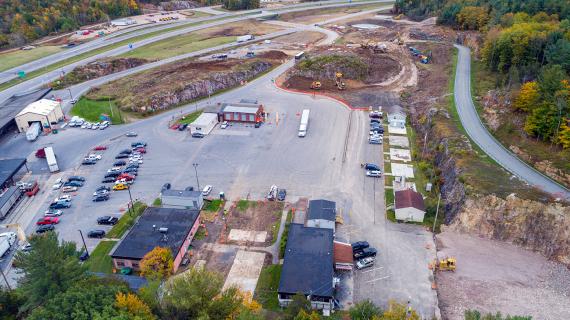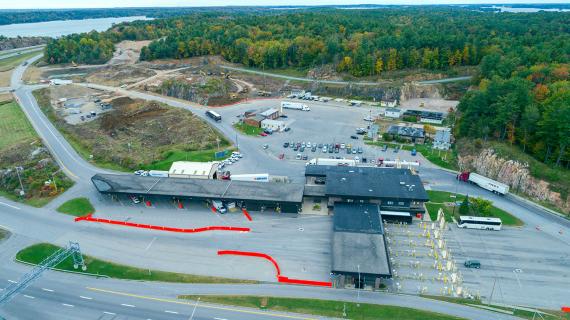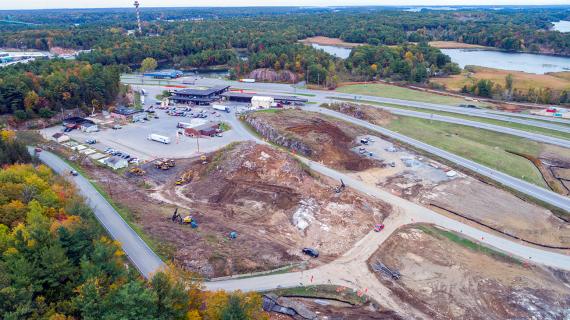Modernization of Alexandria Bay land port ongoing
By Nisha Jasani



With more than 200,000 commercial vehicles and barely over 590,000 passenger vehicles, the Alexandria Bay Land Port of Entry (LPOE), is the sixth busiest crossing for U.S.-bound commercial vehicles along the U.S. border with Canada.
Also known as the Thousand Islands Border Station, the land port is located on Wellesley Island, New York, in the western straits of the St. Lawrence River.
The U.S. Customs and Border Protection (CBP), Immigration and Customs Enforcement (ICE), Department of Agriculture’s Animal and Plant Health Inspection Service – Veterinary Services (APHIS-VS), and Food and Drug Administration (FDA) inspect and process vehicles and individuals entering the United States from Canada. The General Services Administration (GSA) owns, operates, and maintains the facility.
For a facility that’s over 40 years old, providing CBP’s officers with a modern facility is critical to ensure they are best able to complete their mission, according to Tim Walker, area port director for U.S. Customs and Border Protection.
There is also an insufficient amount of queuing space for the traffic that passes through the LPOE and the tenants conduct more and different inspections than the original port was designed to accommodate, said Andrew Woodring, Project Manager, High Risk Project Division.
These problems will be resolved in a two-phase $215 million construction project that began in summer 2017 that allow greater flexibility for the agencies’ changing needs. “The rebuild will be of minimal impact to port operations,” Walker said.
The majority of the port will be constructed of concrete and metal. Approximately 7,900 cubic yards of cast-in-place concrete is estimated to be used for phase 1 and 17,100 cubic yards for phase 2.
Recognizing the need for a complete modernization, GSA in June 2017 awarded a contract to Northland/Cianbro Joint Venture based in Pittsfield, Maine.
The completed land port will feature larger queuing and secondary inspection areas, more inspection lanes, and better-defined truck queuing and maneuvering areas in addition to many other enhancements. The existing roadways will be shifted, lengthened, or altered to accommodate the new port operations.
All 14 new primary lanes will be equipped to process passenger traffic with eight of those equipped for both commercial and passenger vehicles. This is an increase of five passenger lanes and five commercial lanes as compared to that of the existing facility. “With the increase in inspectional lanes, new technology and a better infrastructure, the finished project will increase the overall efficiency of the port and improve traffic flow,” Walker said.
In addition to expanded primary lanes and commercial dock space, a modern facility will provide CBP officers with a workplace that allows them to fulfill their duties and also meets current, modern design standards. The new facility will include the following:
- New administration building
- New commercial inspection building and warehouse with seven docks
- New non-intrusive inspection building
- New maintenance building
- New and expanded commercial vehicle queuing, inspection, and parking areas
- Seven new split-level booths, canopy and inspection lanes suitable for both commercial and noncommercial primary inspection, including one oversized commercial lane with expansion capability for four additional lanes
- Seven non-commercial vehicle inspection lanes (includes one lane dedicated to NEXUS and one dual use) and booths with canopy and expansion capability for three additional lanes
- One new bus lane
- New export control building and associated traffic lanes, including a secondary export inspection area with canopy for two non-commercial vehicles
- Broker office space in the commercial building
- New livestock processing (Veterinary Services) facility with wastewater treatment
The majority of people crossing in passenger vehicles are tourists traveling from the Ottawa, Kingston, Toronto and Montreal regions, with some travelers bound for the U.S. for business reasons. Agriculture include commercial shipments of potatoes, lettuce, yeast and many shipments of corn that is refined to produce ethanol. Livestock includes cattle, ducks, pigs and horses, Walker said.
“It is a complete modernization and expansion of the U.S. land port of entry at Alexandria Bay, New York. All existing buildings will be demolished and replaced by new facilities,” Woodring said.
For more information and updates on the project, visit gsa.gov/alexbaylpoe.

 U.S. General Services Administration
U.S. General Services Administration